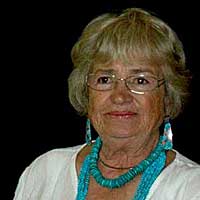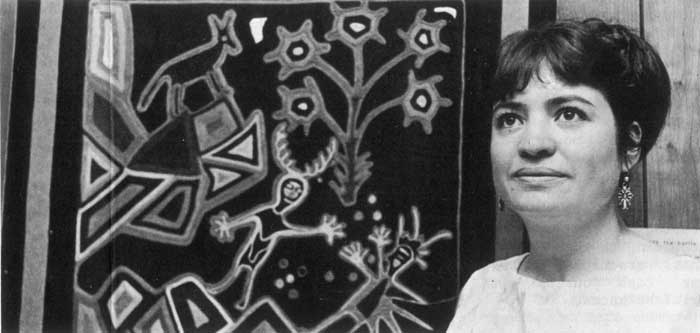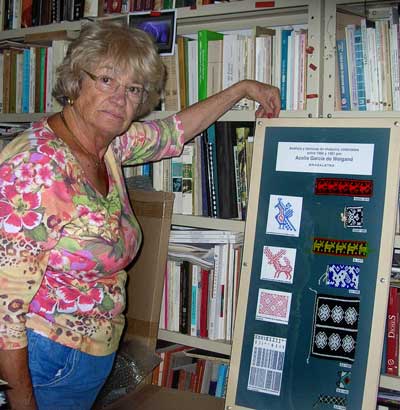|
By John Pint
 In
a ceremony held in the Degollado Theater on November 15, art historian
Acelia Garcia de Weigand was presented with the “Woman of 2011” award
in the field of culture by Radio Mujer which is broadcast in 386
Mexican cities. In
a ceremony held in the Degollado Theater on November 15, art historian
Acelia Garcia de Weigand was presented with the “Woman of 2011” award
in the field of culture by Radio Mujer which is broadcast in 386
Mexican cities.
Garcia is author of the
book Chaquira de los Indígenas Huicholes (Huichol Beadwork), based on
observations and collections she made during the thirty
months she and her late husband
archaeologist Phil Weigand lived with the Huicholes in the
remote village of San Sebastián Teponahuastlán, Jalisco. Nowadays the
Huicholes refer to themselves as Wixáricas (pronounced
wee-SHA-ree-kas), which, says Garcia, means “nosotros” (us).
“I was shocked,” said
the researcher when she heard about the award; “I thought they were
kidding!” These sentiments echo Garcia’s surprise in 1968 when Southern
Illinois University Carbondale asked her to teach a hands-on course in
Huichol art techniques (weaving, yarn painting and beadwork) even
though she didn’t have a degree at that time. Her expertise, in fact,
goes back to her childhood when she learned handicrafts in her village
of Tepec, Amacueca. Later, in San Sebastián, she was able to deeply
analyze local techniques and then apply this knowledge to the beadwork
collections of Carl Lumholtz, Leon Diguet and Robert Zingg as well as
her own personal collection which began in 1965 and continues to this
day.

Acelia
Garcia Weigand in 1968 in the
Southern Illinois University Adult Education News, which announced her
courses in Huichol Crafts:
Mrs. Celia
Weigand displays an example of the Huichol Indian art of Western Mexico
which she will teach this fall. The course will include instruction in
weaving, yarn painting and beadwork, with students producing their own
examples of the craft. The class wilol meet from 7 to 10 p.m. Thursdays
for ten weeks. Mrs. Weigand is the wife of SIU anthropologist Phillip
Weigand, and learned the crafts in her native Mexico.
Garcia says the purpose of her book, which is an abridged translation
of her master’s thesis at State University, N.Y., is to prove “that
these designs and techniques belong to the Huicholes of Jalisco and
Nayarit, Mexico and to make sure no one else lays claim to them.”
Beadwork and Math
Garcia went to live in
San Sebastián in 1965, originally to cook for her husband Phil Weigand
who was working on his Ph.D. on land use by the Huicholes. She spent
her days with the women, as was the custom, and became interested in
how the local designs were being transferred back and forth between
weaving, cross-stitching and beadwork. “I was so enthralled by the work
of these very intelligent women—none of whom had ever gone to
school—that I forgot all about how miserable it was sleeping on the
ground. I discovered to my surprise, that beadwork is very
mathematical.”
Ethnographers with fleas
Asked about living
conditions in the village, she reminisced: “Well, we had a down
sleeping bag with more fleas in it than feathers and we slept on the
ground and we didn’t mind. We were so happy and so interested in the
culture! The truth is, when we first arrived in San Sebastián, people
were hostile. Before going there, we had been told not to say we were
historians or archaeologists, but “ethnographers” because no one would
understand what that meant. But when we got there, we discovered that
what actually worried the local people was that Phil, being an
American, might secretly be working for a mining company and they
figured I was an escort he had rented to fool them.

Smart Huicholes
“So when we got there,
we were sleeping out in the open, but pretty soon the president of the
community came along and gave us a “room” –with no roof—in an abandoned
church that was falling to pieces. Now, they had a disused church there
because these people in San Sebastián were maybe the most traditional
of all the Huicholes…but they were smart. When a priest arrived among
them, they allowed him to make all the adobe bricks he wanted. Then
they accused him of something scandalous (It was actually not true),
threw him out and used the adobe to build their own town
hall. But we were soon accepted by the people and never had a
problem with them, only with the dogs that used to come and rob our
kitchen at night.
“Now Phil had a guide to
take him out where he could study the use of the land, while I spent
all my time with the ladies. In those days, all the Huichol artwork was
made exclusively by the women. In time, I learned a lot of
Huichol and I got along well with the women.
According to Lumholtz
"Phil had Lumholtz’s
book with him and I started reading it and I didn’t agree at all with
what he was saying! His description of their behavior was not far from
what I was seeing, but the interpretation was different. I didn’t
believe everything was symbolic, as Lumholtz claimed. You know,
Lumholtz had studied to become a priest and he was biased toward
symbolism. So Phil and I would have big discussions on this: ‘You can’t
do this and you can’t do that,’ he would say, ‘because according to
Lumholtz…’ and I would reply, ‘What does a Norwegian man know about
Huichol women? You and Lumholtz can go jump in the lake; I’m going to
do what I want to do.’ And I did it my way and I never got
into trouble.
“Most of the people who
wrote about the Huicholes focused on peyote rituals and sensationalism,
and they stereotyped the Huicholes. But in my book there is no
sensationalism. I talk about transitions of techniques, how the colors,
the designs, the weaving, the cross-stitching changed. You know,
cross-stitching done by a Mestizo woman like me and by a Huichol might
look the same on top, but if you turn it over, it looks very different.
I could see how imaginative they were, so smart!”
Acelia Garcia’s study
has never ended. “This is the fifth generation I am studying. Now one
of my sources is a policewoman at the Puente Grande Prison and she is
doing beadwork for this collection: she and her children do excellent
work.”
Garcia’s
first collection is now housed at the Museo de las Artes Populares in
Guadalajara, San Felipe 211 at Pino Suarez. It’s open Sundays 10AM to
4PM and Tuesday to Saturday, 10AM to 6PM (Tel: 3614-3891).
You can
also purchase a well-made documentary DVD in English on Acelia Garcia
and Huichol Beadwork from Explora Mexico, Tel (33) 1086 4428, Email
[email protected] .
|

